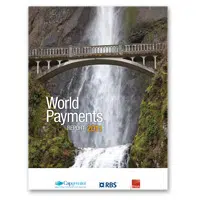Mobile payments will represent 15% of all card transactions by 2013, and will overcome card volumes within 10 years if growth continues at the same rate, according to the World Payments Report 2011.

The current growth in adoption of mobile payments means that transactions made using a mobile phone will outstrip payments made via conventional plastic cards within ten years, according to the World Payments Report 2011.
The report, produced jointly by Capgemini, The Royal Bank of Scotland (RBS) and Efma examines the latest developments in the global payments landscape, including trends in payments volumes and instrument usage, payments-related regulatory initiatives and the strategic considerations and options for banks that result. Key findings include:
- Globally, cards remain the preferred non-cash payment instrument, with global transaction volumes up almost 10% and a market share of more than 40% in most markets.
- Mobile payments will represent 15% of all card transactions by 2013, and will overcome card volumes within 10 years if growth continues at the same rate.
- The use of both e-payments and m-payments is expanding, accounting for an estimated 22.5bn transactions worldwide in 2010.
- E-payments are expected to grow globally from 17.9bn to 30.3bn transactions between 2010 and 2013 according to the report. M-payments will grow from 4.6bn to 15.3bn transactions over the same period.
- The use of cheques continues to lessen, accounting for just 16% of all non-cash global transactions in 2009 — down from 22% in 2005.
The report also provides an analysis of global and regional regulatory and industry initiatives, ranging from Basel III to the Digital Agenda for Europe, from the Dodd-Frank Act to the work of the National Payments Corporation of India. Five key industry transformation trends are identified which, the authors say, are together reshaping — or soon will reshape — aspects of the payments market and the positioning of the players who operate within it:
- Systemic-risk reduction and control: In the wake of the financial crisis, regulators are seeking to reduce systemic risk by asking for stricter requirements on capital and liquidity.
- Standardisation initiatives aimed at improving efficiency, streamlining processes and reducing costs continue: Some payments instruments and aspects of the value chain are commoditised in the process, making it more difficult for banks to differentiate themselves.
- A drive for higher levels of transparency: Several initiatives are concentrating on making service fees to customers more transparent, with potential implications for current business models, such as cards.
- Convergence: Developments in technology and evolving user and regulatory requirements are contributing to a gradual blurring of the lines between traditional payments activities supplied by infrastructure providers, potentially increasing competition between real-time gross settlement (RTGS) systems and automated clearing houses (ACHs) for certain types of low-value payments.
- Innovation: This remains a critical success factor within the payments industry, allowing players to harness emerging technologies and trends, such as mobile devices and contactless payments, to deliver state-of-the-art solutions to meet evolving user needs.
“As the trend towards further standardisation in the payments market continues, it is driving increased commoditisation of many aspects of the value chain,” say the authors. “Banks and other payment services providers (PSPs) face a heightened challenge to distinguish their propositions and may increasingly need to specialise to demonstrate their ongoing value to their customers. Innovation in this area remains vital for banks/PSPs, allowing them to differentiate their propositions and prove their value.
“In the mid- to long-term, the traditional fully-integrated payments model (from supply to delivery) may no longer be optimal for most PSPs. We could see the emergence of two specialist roles: wholesale payments provider (WPP) and retail payment services provider (RPSP), with very few players in the market able to support the investments needed to play both roles. Evolving into a WPP, RPSP, or both requires important strategic decisions to be made, and will drive banks to understand the role(s) they wish to play in such a future and prepare for this potentially radical shift.”
“The evolution of the payments sector is accelerating,” says Patrick Desmarès, secretary general of Efma. “As banks and PSPs consider this reality, they will need to find ways to thrive in the payments market in the nearer-term while positioning themselves to mitigate the risks and capitalise on the opportunities created by the industry’s transformation in the longer-term.”
Next: Visit the NFCW Expo to find new suppliers and solutions
Thanks to the proliferation of smart phones and NFC capabilities across geographies, mobile payment is certainly poised to continue its stellar growth. According to the Juniper Research forecast in April ’11 (http://www.nfcw.com/2011/04/18/37073/nfc-news-in-brief-18-april-2011/), at least one in five smartphones worldwide will have NFC capability by 2014. Not surprisingly, within the mobile payments space, in the coming years, the adoption of NFC technology is poised to increase tremendously; overtaking the number of SMS mobile transactions.
Today, non-bank providers of mobile payments are increasingly challenging banks to distinguish the value proposition of their mobile payments solution. Hence, banks cannot ignore their mobile payments channel and treat it as a commodity. In order to make their mobile payment solution stand out, it is crucial for banks to develop their long term mobile banking solution roadmap. They must also choose the right partner who not only helps them define their unique road map but also has the capability to implement it. Read an article from Infosys (http://www.infosys.com/FINsights/Documents/pdf/issue7/deploying-mobile-right-partner.pdf) that explores different partnership options for banks to deploy mobile solutions, and provides a view on what a bank should consider while selecting a partner.
It seems that mobile payments has been accelerating with the latest innovation in mobile technology. Forrester Research predicting that mobile commerce will hit $6 billion in 2011 – and reach up to $31 billion by 2016. Even Paypal had revised their mobile payments projections 3 times for 2011 from $1.5 billion to $3.0 billion. Though the impact on card volume prediction is remained constant over the period. Also unbanked people in emerging markets will play key role in mobile payments.